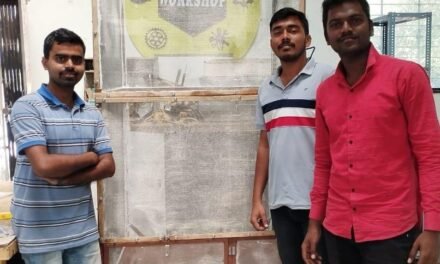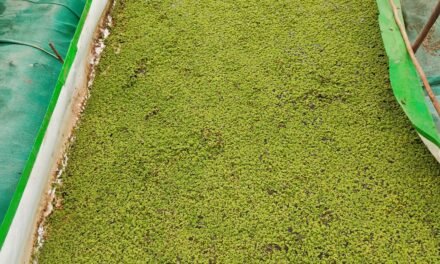Date – 2/01/2023 to 6/01/2023
Introduction:-
A lot of water is wasted due to overflow while filling the tank of the meditation hall. Seeing this problem, Ranjit sir gave me the project to make water level indicator for the water tank of meditation hall.
In today’s twentieth century, everyone has a habit of running away. Everyone is in a hurry and no one wants to stop So sometimes we forget some things. A job happens in everyone’s home. This is the work of filling the water tank, while doing this we start the water motor, but we forget to turn off the water motor. This story is not found in every household but everywhere. Like in hostels, hospitals, complexes, wherever there are water tanks, there is a noise. The tank is full Turn off the motor. The same thing was happening in our Vigyan Ashram. To get satisfaction from these things, we experimented with the bell ringing after filling the water tank. So you know the water tank is full.
Problem statement:–
The water tank of the meditation hall overflows at the time of filling. water is wasted
Once the water tank is full, some water is wasted.
There is an increase in the electricity bill.
Objective:
Water should not be wasted.
Saving electricity.
Electronic Component:-
- Arduino Uno
- Float sensor
- Speaker (12v)
- SMPS(12v 3a)
- Relay (5V)
Electrical material:-
- 2 core wire
- Electrical switch Board
- Single Holder Adapter
- Electric Holder
- junction box electrical



Bill of Material
| S.r No. | Material | Cost | Quantity | Availability |
| 1 | Arduino uno | 700 | 1 | Yes |
| 2 | Float sensor | 105 | 1 | Yes |
| 3 | Relay 5v | 35 | 1 | Yes |
| 4 | Speaker | 700 | 1 | Yes |
| 5 | SMPS | 1500 | 1 | Yes |
| 6 | Wire | 375 | 15 meter | No |
| 7 | Electrical switch Board | 50 | 1 | No |
| 8 | Electric Holder | 16 | 1 | Yes |
| 9 | single Holder adapter | 10 | 1 | Yes |
| 10 | junction box electrical | 250 | 1 | NO |
| 11 | Wire clip | 20 | 50 | Yes |
| Total – 3761 |
Arduino Uno:-
The Arduino is an open-source electronics platform based on easy-to-use hardware and software used to build electronics projects. All Arduino boards have one thing in common which is a microcontroller. A microcontroller is basically a really small computer.

The Arduino boards are basically a tool for controlling electronics. They are able to read inputs with their onboard microcontroller (eg. Light on a sensor, an object near a sensor) and turn it into an output (Drive a motor, ring an alarm, turn on an LED, display information on an LCD).
Float sensor
In short, a float switch is a mechanical switch that floats on top of a liquid surface. As the liquid level goes up or down, it moves vertically with the liquid level. Depending on the counterweight and pre-set ‘trigger’, the mechanical switch opens or closes allowing an electrical current through it to the connected device. Typically, this connected device either stops or starts the inflow of the liquid.
The float switch consists of a hollow floating body and an internal switch, also called a sensor. The most common internal switch is a reed switch, so there is also a magnet inside the body. There are other types of internal switches, but the working principle that they open/close due to gravity and water level moving the float switch vertically up or down is the same. Therefore, the mechanical switch creates an open or closed electrical circuit.

The float sensor consists of an electromagnetic switch. It operates just like any other switch. Here a Magnetic reed switch is placed in the stem of the sensor. A magnet will be in the bulb structure of float sensor. When water fills up in a reservoir the bulb structure which has the magnet starts moving up once water reaches a certain level. It moves up close to stem near the reed switch. Due to the force of attraction from this magnet reed switch closes indicating water level is high.
When the water level goes down the bulb moves down and reed switch contact breaks and by this way the system detects that water level has gone down and acts accordingly.

- The maximum switch current of the float is 0.5A and the switch voltage of 100V DC.
- The temperature rating is about 10-85 degrees centigrade.
- The power rating of this sensor is about 10W.
- The entire body of this sensor is made up of plastic.
Relay:-
5V Single-Channel Relay Module
Relay is an electromechanical device that uses an electric current to open or close the contacts of a switch. The single-channel relay module is much more than just a plain relay, it comprises of components that make switching and connection easier and act as indicators to show if the module is powered and if the relay is active or not.
Single-Channel Relay Module Pin Description.
| Pin Number | Pin Name | Pin Description |
| 1 | Relay trigger | Input to activate the relay |
| 2 | Ground | 0V reference |
| 3 | VCC | Supply Input for powering the relay coil |
| 4 | Normally Open | Normally Open Terminal of the relay |
| 5 | Common | Common Terminal of the relay |
| 6 | Normally closed | Normally closed Terminal of the relay |
Single-Channel Relay Module Specifications
- Supply voltage – 3.75V to 6V
- Quiescent current: 2mA
- Current when the relay is active: ~70mA
- Relay maximum contact voltage – 250VAC or 30VDC
- Relay maximum current – 10A

Normally Open Contact (NO) – NO contact is also called a make contact. It closes the circuit when the relay is activated. It disconnects the circuit when the relay is inactive.
Normally Closed Contact (NC) – NC contact is also known as break contact. This is opposite to the NO contact. When the relay is activated, the circuit disconnects. When the relay is deactivated, the circuit connects.
Change-over (CO) / Double-throw (DT) Contacts – These types of contacts are used to control two types of circuits. They are used to control a NO contact and also an NC contact with a common terminal. According to their type, they are called by the names break before make and make before break contacts.

SMPS:-
The power supply circuit plays an important role in every electrical and electronic circuit to supply power from the owl circuit to the computer and various machines. The full name of SMPS is Switch-Mode Power Supply.SMPS is defined in simple language when the need for electricity comes in the form of a switch. In which electrical energy is converted from one form to another with essential properties called SMPS.
In this type of SMPS, the input supply is AC and in the output, we get DC supply. Rectifiers and filters are used to convert this AC power to DC. This uncontrollable DC voltage is given to the affected power factor correction circuits. This is because there is a low current pulse inside the rectifier around the peak of the voltage.

How does SMPS work
The SMPS device uses switching regulators that switches the load current on and off to regulate and stabilize the output voltage. The average of the voltage between the off and on produces the appropriate power for a device. Unlike the linear power supply, the pass transistor of SMPS switches between low dissipation, full-on and full-off mode, and spends very less time in the high-dissipation transitions, which minimizes wasted energy.( https://www.javatpoint.com/smps-full-form)
SPEAKER (12V) :-
12v 3ah speaker is used for this project. The reason for installing this speaker is that when the water tank is full, everyone can hear its loud sound.

Connection:-

Relay
- Generally, the Relay has at least 6 pins (one side 3 and second side 3).
- GND (ground) is connected to Arduino GND pin
- VCC is the supply pin which is connected to Arduino 5V pin.
- Output(in) pin is serial data line, connected to Arduino Digital pin 11D.
- Connect the positive wire of the Speaker to the normally open of the relay.
- Connect the positive wire of the power supply to the common of the relay.
- Connect the negative wire of the power supply and the Speaker together.
- Connect the negative wire of the power supply and the Speaker together.
Float sensor
- Generally, the Float sensor has at 2 wire .
- GND (ground) is connected to Arduino GND pin
- VCC is the connected to Arduino 10D pin.
Code:-
#define relay 10
#define FS 11
int senstate;
bool x;
void setup() {
Serial.begin(9600);
// initialize digital pin 8 as an output.
pinMode(relay, OUTPUT);
pinMode(FS, INPUT_PULLUP);
digitalWrite(relay, HIGH);
x=false;
}
void loop() {
senstate = digitalRead(FS);
if (senstate == 1)
{
if (x)
{
digitalWrite(relay, HIGH);
delay(500);
digitalWrite(relay, LOW);
delay(1000);
digitalWrite(relay, HIGH);
delay(500);
digitalWrite(relay, LOW);
delay(500);
digitalWrite(relay, HIGH);
delay(500);
digitalWrite(relay, LOW);
delay(500);
digitalWrite(relay, HIGH);
delay(500);
digitalWrite(relay, LOW);
delay(500);
digitalWrite(relay, HIGH);
x = false;
Serial.println(“STEP ONE DONE”);
}
}
else if (senstate == 0)
{
if (!x)
{
digitalWrite(relay, HIGH);
x = true;
Serial.println(“STEP TWO DONE”);
}
}
delay(1000);
}
Soldering all the components.

AC supply connection
Meditation hall to meditation hall terrace

Set box on the wall.

Set the sensor according to the water level in the tank.

conclusion:-
During this project I learned about float sensor.
learned to do SMPS connection.





